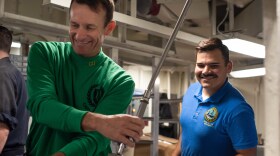The Navy is trying to figure out what the "new normal" will be after two years of battling COVID-19.
In the opening months of the pandemic, the Navy was caught off guard. In April 2020, it was forced to sideline the USS Roosevelt in Guam for more than a month to try to stop a quickly spreading COVID-19 outbreak on board.
Eventually, more than a third of the sailors were infected. One sailor on the carrier died.
The Navy relieved the Roosevelt's commanding officer, Capt. Brett Crozier, after a letter leaked in which he complained the Navy wasn’t doing enough to get sailors off the ship.
The situation became a case study on how not to handle COVID-19.
“The Roosevelt was made much worse largely by self-inflicted wounds by the Navy,” said Brad Martin, a retired Navy captain who is now a researcher with Rand Corporation.
Martin said the Navy underestimated the risk of COVID-19 and was slow to react.
“They were befuddled because they were getting a lot of conflicted guidance,” he said. “They were befuddled because the medical chain of command was telling people one thing, the operational chain of command was telling them something else.”
The situation improved as the pandemic progressed. Initially, the Navy imposed mask rules and began requiring sailors to spend time in isolation before boarding ships. Later, it announced that no sailor can deploy without being vaccinated.
As the aircraft carrier USS Lincoln was about to depart from San Diego in early January, the head of the strike group, Rear Adm. J.T. Anderson, assured reporters the Navy now has its act together.
“Frankly, we’ve learned a lot over the course of the last couple of years,” Anderson said. "We feel we are in a good place because we are highly vaccinated."
The standards have continued to evolve. In recent weeks, the Navy has eased some of the stricter policies that were put in place after the USS Roosevelt outbreak.
Among the recent changes: Sailors are now allowed to deploy even if they have active COVID-19 cases. Anderson said the crew of the USS Lincoln included 3000 infected sailors.
"We do have some positive cases within the strike group, but again we’re extremely confident that we can safely and effectively execute our mission,” he said.
The Navy also said sailors only need to wear masks for the first ten days they're aboard ship or if a new COVID case appears on board. And sailors are no longer isolated before boarding.
“We no longer lock them down for two weeks before they go at the pier," said Vice Adm. William Merz, the Deputy Chief of Naval Operations. "These are all the draconian things we did up front. So we've learned over time, and I think the whole world has learned over time, that's probably less effective.”
The latest set of rules has no end date, but Merz hopes the Navy won’t have to live with COVID-19 forever.
“Once you declare it endemic, you've kind of surrendered," he said. "I think there's still too much compelling evidence that you can manage this thing, and you can live without it if you apply all the tools in place.“

The Navy has a 98% vaccination rate, but thousands of sailors have applied for exemptions from the vaccination mandate - many on religious grounds.
So far, the Navy has granted some medical exemptions. It hasn’t granted any religious exemptions, though a federal judge has blocked the Navy from taking action against 35 SEALs who are suing on religious grounds.
Martin, who wrote a paper on how the Navy handled the outbreak on the USS Roosevelt, said the Navy has made progress keeping sailors healthy. Still, he questions whether leaders are putting too much emphasis on keeping ships at sea, even on non-essential missions.
“The Navy needs to think seriously about what's really a definite 'must-do' deployment and what's something that can wait," Martin said.
This story was produced by the American Homefront Project, a public media collaboration that reports on American military life and veterans. Funding comes from the Corporation for Public Broadcasting.





